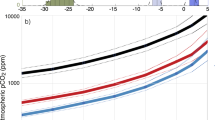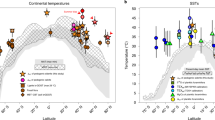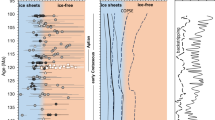Abstract
The quantification of greenhouse gases present in the Archaean atmosphere is critical for understanding the evolution of atmospheric oxygen, surface temperatures and the conditions for life on early Earth. For instance, it has been argued1,2,3,4 that small changes in the balance between two potential greenhouse gases, carbon dioxide and methane, may have dictated the feedback cycle involving organic haze production and global cooling. Climate models have focused on carbon dioxide as the greenhouse gas responsible for maintaining above-freezing surface temperatures during a time of low solar luminosity5,6. However, the analysis of 2.75-billion-year (Gyr)-old7 palaeosols—soil samples preserved in the geologic record—have recently provided an upper constraint on atmospheric carbon dioxide levels well below that required in most climate models to prevent the Earth's surface from freezing. This finding prompted many to look towards methane as an additional greenhouse gas to satisfy climate models1,4,8,9. Here we use model equilibrium reactions for weathering rinds on 3.2-Gyr-old river gravels to show that the presence of iron-rich carbonate relative to common clay minerals requires a minimum partial pressure of carbon dioxide several times higher than present-day values. Unless actual carbon dioxide levels were considerably greater than this, climate models5,6,8 predict that additional greenhouse gases would still need to have a role in maintaining above-freezing surface temperatures.
This is a preview of subscription content, access via your institution
Access options
Subscribe to this journal
Receive 51 print issues and online access
$199.00 per year
only $3.90 per issue
Buy this article
- Purchase on Springer Link
- Instant access to full article PDF
Prices may be subject to local taxes which are calculated during checkout



Similar content being viewed by others
References
Pavlov, A. A., Kasting, J. F., Brown, L. L., Rages, K. A. & Freedman, R. Greenhouse warming by CH4 in the atmosphere of early Earth. J. Geophys. Res. 105, 11981–11990 (2000)
Sagan, C. & Chyba, C. The early faint sun paradox: Organic shielding of ultraviolet-labile greenhouse gases. Science 276, 1217–1221 (1997)
Brown, L. K. Numerical Models of Reducing Primitive Atmospheres on Earth and Mars. Thesis, Penn State Univ. (1999)
Catling, D. C., Zahnle, K. J. & McKay, C. P. Biogenic methane, hydrogen escape, and the irreversible oxidation of the early Earth. Science 293, 839–843 (2001)
Kasting, J. F. Earth's early atmosphere. Science 259, 920–926 (1993)
Hart, M. H. Evolution of the atmosphere of the Earth. Icarus 33, 23–29 (1978)
Rye, R., Kuo, P. & Holland, H. D. Atmospheric carbon dioxide concentrations before 2.2 billion years ago. Nature 378, 603–605 (1995)
Sleep, N. H. & Zahnle, K. Carbon dioxide cycling and implications for climate on ancient Earth. J. Geophys. Res. 106, 1373–1399 (2001)
Rye, R. & Holland, H. D. Life associated with a 2.76 Ga ephemeral pond? Evidence from Mount Roe paleosol. Geology 28, 483–486 (2000)
Kamo, S. L. & Davis, D. W. Reassessment of Archean crustal development in the Barberton Mountain Land, South Africa, based on U-Pb dating. Tectonics 13, 167–192 (1994)
Heubeck, C. E. & Lowe, D. R. Depositional and tectonic setting of the Archean Moodies Group, Barberton Greenstone Belt, South Africa. Precambr. Res. 68, 257–290 (1994)
Eriksson, K. A. Alluvial and destructive beach facies from the Archean Moodies Group, Barberton Mountain Land, South Africa and Swaziland. Mem. Can. Soc. Petrol. Geol. 5, 287–311 (1978)
Mozley, P. S. Relationship between depositional environment and the elemental composition of early diagenetic siderite. Geology 17, 704–706 (1989)
Hessler, A. M. Evidence for Climate and Weathering in Siliciclastic Sedimentary Rocks of the 3.2 Ga Moodies Group, Barberton Greenstone Belt, South Africa. Thesis, Stanford Univ. (2001)
Postma, D. Pyrite and siderite formation in brackish and freshwater swamp sediments. Am. J. Sci. 282, 1151–1183 (1982)
Eugster, H. P. & Chou, I. The depositional environments of Precambrian banded iron-formations. Econ. Geol. 68, 1144–1168 (1973)
Rye, R. & Holland, H. D. Paleosols and the evolution of atmospheric oxygen; a critical review. Am. J. Sci. 298, 621–672 (1998)
Macfarlane, A. W., Danielson, A. & Holland, H. D. Geology and major trace element chemistry of late Archean weathering profiles in the Fortescue Group, Western Australia: implications for atmospheric P O 2 . Precambr. Res. 65, 297–317 (1994)
Yang, W. & Holland, H. D. The Hekpoort paleosol profile in Strata 1 at Gaborone, Botswana: Soil formation during the great oxidation event. Am. J. Sci. 303, 187–220 (2003)
Rasmussen, B. & Buick, R. Redox state of the Archean atmosphere; evidence from detrital heavy minerals in ca. 3250–2750 Ma sandstones from the Pilbara Craton, Australia. Geology 27, 115–118 (1999)
Krupp, R. et al. The early Precambrian atmosphere and hydrosphere: Thermodynamic constraints from mineral deposits. Econ. Geol. 89, 1581–1598 (1994)
Grandstaff, D. E. Origin of uraniferous conglomerates at Elliot Lake, Canada and Witwatersrand, South Africa; implications for oxygen in the Precambrian atmosphere. Precambr. Res. 13, 1–26 (1980)
Holland, H. D. The Chemical Evolution of the Atmosphere and Oceans (Princeton Univ. Press, New Jersey, 1984)
Farquhar, J., Bao, H. & Thiemens, M. Atmospheric influence of Earth's earliest sulfur cycle. Science 289, 756–758 (2000)
Knauth, L. P. & Lowe, D. R. High Archean climatic temperature inferred from oxygen isotope geochemistry of cherts in the 3.5 Ga Swaziland Supergroup, South Africa. Geol. Soc. Am. Bull. 115, 566–580 (2003)
Kiehl, J. T. & Dickinson, R. E. A study of the radiative effects of enhanced atmospheric CO2 and CH4 on early Earth surface temperatures. J. Geophys. Res. 92, 2991–2998 (1987)
Johnson, J., Oelkers, E. & Helgeson, H. SUPCRT92: a software package for calculating the standard molar thermodynamic properties of minerals, gases, aqueous species, and reactions from 1 to 5000 bar and to 1000 degrees C. Comput. Geosci. 18, 899–947 (1992)
Wolery, T. J. EQ3/6: A Software Package for Geochemical Modeling of Aqueous Systems (The Regents of the University of California and Lawrence Livermore National Laboratory, Berkeley, 1997)
Ekart, D. D., Cerling, T. E., Montanez, I. P. & Tabor, N. J. A 400 million year carbon isotope record of pedogenic carbonate: Implications for paleoatmospheric carbon dioxide. Am. J. Sci. 299, 805–827 (1999)
Berner, R. A. & Kothvala, Z. GEOCARB III: A revised model of atmospheric CO2 over Phanerozoic time. Am. J. Sci. 301, 182–204 (2001)
Acknowledgements
We appreciate the help and samples we received from Avgold and ETC Mines, Barberton, South Africa. Electron microprobe analysis was performed at the Center for Materials Research and Department of Geological and Environmental Sciences at Stanford University. We thank T. Fridriksson, K. Lemke, C. Oze and A. Fildani for technical support and advice, and N. Sleep for comments on early versions of this manuscript. This work was supported by the NASA Exobiology Program (D.R.L.) and the National Science Foundation (D.K.B.).
Author information
Authors and Affiliations
Corresponding author
Ethics declarations
Competing interests
The authors declare that they have no competing financial interests.
Rights and permissions
About this article
Cite this article
Hessler, A., Lowe, D., Jones, R. et al. A lower limit for atmospheric carbon dioxide levels 3.2 billion years ago. Nature 428, 736–738 (2004). https://doi.org/10.1038/nature02471
Received:
Accepted:
Issue Date:
DOI: https://doi.org/10.1038/nature02471
This article is cited by
-
Liquid and supercritical CO2 as an organic solvent in Hadean seafloor hydrothermal systems: implications for prebiotic chemical evolution
Progress in Earth and Planetary Science (2022)
-
The structural basis of Rubisco phase separation in the pyrenoid
Nature Plants (2020)
-
Mission to Planet Earth: The First Two Billion Years
Space Science Reviews (2020)
-
Geoscience for Understanding Habitability in the Solar System and Beyond
Space Science Reviews (2019)
-
Snowball Earth at low solar luminosity prevented by the ocean–atmosphere coupling
Acta Geochimica (2019)
Comments
By submitting a comment you agree to abide by our Terms and Community Guidelines. If you find something abusive or that does not comply with our terms or guidelines please flag it as inappropriate.



